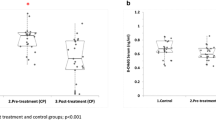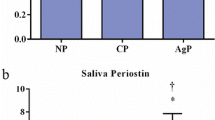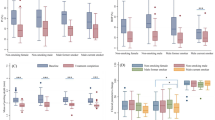Abstract
This case-controlled clinical trial was performed on the salivary 8-hydroxyguanosine (8-OHdG) levels in smokers and non-smokers with chronic periodontitis after non-surgical periodontal therapy. Subjects (N = 40) with periodontitis (smokers and non-smokers) and with clinically healthy conditions (smokers and non-smokers) were assigned to this study. At baseline, clinical periodontal parameters (plaque index, gingival index, pocket probing depth and clinical attachment levels) were evaluated. Saliva samples were obtained pre- and post-treatment to quantify the 8-OHdG levels using Elisa technique. Subjects diagnosed with chronic periodontitis with smoking habit (CPs) and non-smokers (CPns) received scaling and root planing. In clinically healthy subjects with smoking habit (CHs) and non-smokers (CHns), only oral hygiene tutoring was performed. All clinical measurements and salivary collection were repeated in a 3-month recall interval. Data were analyzed using Anova, Tukey post hoc test and Mann–Whitney ‘U’ tests (P < 0.05). At baseline, CPs and CPns groups showed significantly higher PI, GI, PD and CAL values than those of CHns and CHs (P < 0.001). Baseline salivary levels of 8-OHdG were significantly higher in CPs group (14.775 pg/mL) (P < 0.001) compared to the other groups. All clinical parameters in chronic periodontitis group improved at the 3rd month recall interval, however, with regards to 8-OHdG values, the CP smoker category still had a higher level compared to CP non-smoker. This study reflects an on-going periodontal destructive status in smokers and salivary 8-OHdG levels could be recognized as an oxidative biomarker for determining periodontal tissue destruction.
Similar content being viewed by others

References
Preber H, Bergström J. The effect of non-surgical treatment on periodontal pockets in smokers and non-smokers. J Clin Periodontol. 1986;13:319–23.
Grossi SG, Skrepcinski FB, DeCaro T, Zambon JJ, Cummins D, Genco RJ. Response to periodontal therapy in diabetics and smokers. J Periodontol. 1996;67:1094–102.
Research, Science and Therapy Committee of the American Academy of Periodontology. Position paper: tobacco use and periodontal patients research. Sci Ther Comm Amer Academ Periodont. 1999;70:1419–27.
Ah MK, Johnson GK, Kaldahl WB, Patil KD, Kalkwarf KL. The effect of smoking on the response to periodontal therapy. J Clin Periodont. 1994;21:91–7.
Guentsch A, Preshaw PM, Bremer-Streck S, Klinger G, Glockmann E, Sigusch BW. Lipid peroxidation and antioxidant activity in saliva of periodontitis patients; effect of smoking and periodontal treatment. Clin Oral Invest. 2008;12:345–52.
Martinez-Canut P, Lorca A, Magan R. Smoking and periodontal disease severity. J Clin Periodontol. 1995;22:743–9.
Tappia PS, Troughton KL, Langley-Evans SC, Grimble RF. Cigarette smoking influences cytokine production and antioxidant defences. Clin Sci. 1995;88:485–9.
Boströsm L, Linder LE, Bergström J. Smoking and crevicular fluid levels of IL-6 and TNF-α in periodontal disease. J Clin Periodontol. 1999;26:352–7.
Chapple IL, Matthews JB. The role of reactive oxygen and anti-oxidant species in periodontal tissue destruction. Periodontol. 2000;2007(43):160–232.
Sulaiman AE, Shehadeh RM. Assessment of total anti-oxidant capacity and the use of vitamin C in the treatment of non-smokers with chronic periodontitis. J Periodont. 2010;81:1547–54.
Battino M, Bullon P, Willson M, Newman H. Oxidative injury and inflammatory periodontal diseases: the challenge of anti-oxidants to free radicals and reactive oxygen species. Crit Review Oral Bio Med. 1999;10:458–76.
Chapple IN. Reactive oxygen species and antioxidants in inflammatory diseases. J Clin Periodontol. 1997;24:287–96.
Ryder MI, Fujitaki R, Johnson G, Hyun W. Alterations of neutrophil oxidative burst by invitro smoke exposure: implications for oral and systemic diseases. Ann Periodontol. 1998;3:76–877.
Halliwell B. Superoxide-dependent formation of hydroxyl radicals in the presence of iron salts: it’s role in the degradation of hyaluronic acid by a superoxide-generating system. FEBS Letts. 1978;96:238–42.
Halliwell B, Gutteridge JMC. Lipid peroxidation, oxygen radicals, cell damage and antioxidant therapy. Lancet. 1984;1:1396–8.
Miller DR, Lamster IB, Chasens AI. Role of the polymorphonuclear leukocyte in periodontal health and disease. J Clin Periodontol. 1984;11:1–15.
Shigenaga MK, Gimeno CJ, Ames BN. Urinary 8-hydroxy-20-deoxyguanosine as a biological marker of in vivo oxidative DNA damage. Proc Natl Acad Sci USA. 1989;86:9697–701.
Cheng KC, Cahill DS, Kasai H, Nishimura S. 8-Hydroxyguanine, an abundant form of oxidative DNA damage, causes GT and AC substitutions. J Biol Chem. 1992;267:166–72.
Wu LL, Chiou CC, Chang PY, Wu JT. Urinary 8-0HdG: a marker of oxidative stress to DNA and a risk factor for cancer, atherosclerosis and diabetics. Clin Chem Acta. 2004;339:1–9.
Arana C, Cutando A, Ferrera MJ, Gomez-Moreno G, Worf CV, Bolanos MJ, Escames G, Cuna-Castroviejo D. Parameters of oxidative stress in saliva from diabetic and parenteral drug addicts patients. J Oral Pathol Med. 2006;35:554–9.
Sawamoto Y, Sugano N, Tanaka H, Ito K. Detection of periodontopathic bacteria and an oxidative stress marker in saliva from periodontitis patients. Oral Microbiol Immunol. 2005;20:216–20.
Takane M, Sugano N, Iwaski H, Uchiyama T, Ito K. A marker of oxidative stress in saliva: association with periodontally-involved teeth of a hopeless prognosis. J Oral Sci. 2005;47:53–7.
Hendek MK, Erdemir EO, Kisa U, Ozcan G. Effect of initial periodontal therapy on the oxidative stress markers in Gingival crevicular fluid, Saliva and serum in smokers and non-smokers with chronic periodontitis. J Periodontol. 2015;86:273–82.
Armitage GC. Development of a classification system for periodontal diseases and conditions. Ann Periodontol. 1999;4:1–6.
Navazesh M. Methods for collecting saliva. Ann N Y Acad Sci. 1993;694:72–7.
Silness T, Loë H. Periodontal disease in pregnancy II. Correlation between oral hygiene and periodontal condition. Acta Odontol Scand. 1964;22:121–35.
Loë H, Silness T. Periodontal disease in pregnancy I. Prevalence and severity. Acta Odontol Scand. 1963;21:533–51.
Kaufman E, Lamster IB. Analysis of saliva for periodontal diagnosis—a review. J Clin Periodontol. 2000;27:453–65.
Sculley DV, Langley-Evans SC. Salivary antioxidants and periodontal disease status. Proc Nutr Soc. 2002;61:137–43.
Su H, Gornitsky M, Velly AM, Yu H, Benarroch M, Schipper HM. Salivary DNA, lipid, and protein oxidation in nonsmokers with periodontal disease. Free Radic Biol Med. 2009;46:914–21.
Arunachalam R, Arunima R, Rajeev V, Kurra S, Prince MR, Syam N. Salivary 8-hydroxydeoxyguanosine: a valuable indicator for oxidative DNA damage in periodontal disease. Saudi J Dent Res. 2015;6:15–20.
Church DF, Pryor WA. Free-radical chemistry of cigarette smoke and its toxicological implications. Environ Health Perspect. 1985;64:111–26.
Honda M, Yamada Y, Tomonaga M, Ichinose H, Kamihira S. Correlation of urinary 8-hydroxy-2'-deoxyguanosine (8-OHdG), a biomarker of oxidative DNA damage, and clinical features of hematological disorders: a pilot study. Leuk Res. 2000;24:461–8.
Zhihai C, Dapeng W, Xing L, Weiwei P, Li J, Cao Y, Zhang J, An Y, Nie J, Tong J. Oxidative DNA damage is involved in cigarette smoke-induced lung injury in rats. Environ Health Prev Med. 2015;20:318–24.
Mbabali M, Mulli TK, Wagaiyu E. Salivary flow rate in adult Kenyans and its relationship with chronic periodontitis. JDOH. 2016;8(7):37–42.
Petrušić N, Posavac M, Sabol I, Mravak-Stipetić M. The effect of tobacco smoking on salivation. Acta Stomatol Croat. 2015;49(4):309–15.
Rad M, Kakoie S, Brojeni FN, Pourdamghan N. Effect of long-term smoking on whole-mouth salivary flow rate and oral health. J Dent Res Dent Clin Dent Prospects. 2010;4(4):110–4.
Gan W, Liu XL, Yu T, Zou YG, Li TT, Wang S, Deng J, Wang LL, Cai JP. Urinary 8-oxo-7,8-dihydroguanosine as a potential biomarker of aging. Front Aging Neurosci. 2018;27(10):34.
Dede FO, Ozden FO, Avcı B. 8-hydroxy-deoxyguanosine levels in gingival crevicular fluid and saliva in patients with chronic periodontitis after initial periodontal treatment. J Periodontol. 2013;84:821–8.
Boström L, Linder LE, Bergstrom J. Influence of smoking on the outcome of periodontal surgery. A 5-year follow-up. J Clin Periodontol. 1998;25:194–201.
Renvert S, Dahlen G, Wikström M. The clinical and microbiological effects of non-surgical periodontal therapy in smokers and non-smokers. J Clin Periodontol. 1998;25:153–7.
Linden GJ, Mullally BH. Cigarette smoking and periodontal destruction in young adults. J Periodontol. 1994;65:718–23.
Haffajee AD, Socransky SS. Relationship of cigarette smoking to attachment level profiles. J Clin Periodontol. 2001;28:283–95.
Axelsson P, Lindhe J. Effect of controlled oral hygiene procedures on caries and periodontal disease in adults. J Clin Periodontol. 1978;5:133.
Author information
Authors and Affiliations
Corresponding author
Ethics declarations
Conflict of interest
The authors declare that they have no conflict of interest.
Additional information
Publisher's Note
Springer Nature remains neutral with regard to jurisdictional claims in published maps and institutional affiliations.
Rights and permissions
About this article
Cite this article
Varghese, J., Bhat, V., Chianeh, Y.R. et al. Salivary 8-hydroxyguanosine levels in smokers and non-smokers with chronic periodontitis. Odontology 108, 569–577 (2020). https://doi.org/10.1007/s10266-020-00496-x
Received:
Accepted:
Published:
Issue Date:
DOI: https://doi.org/10.1007/s10266-020-00496-x



